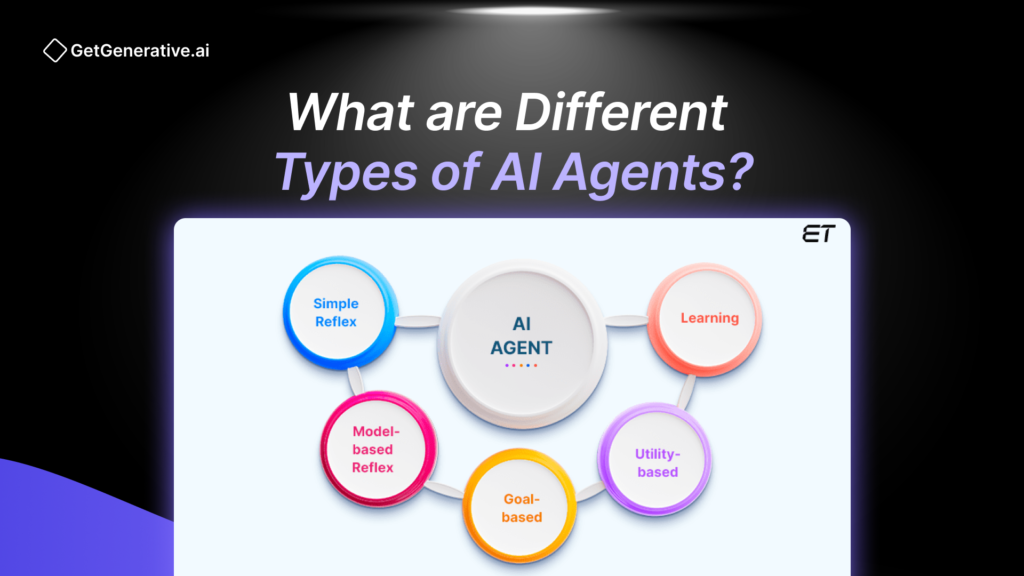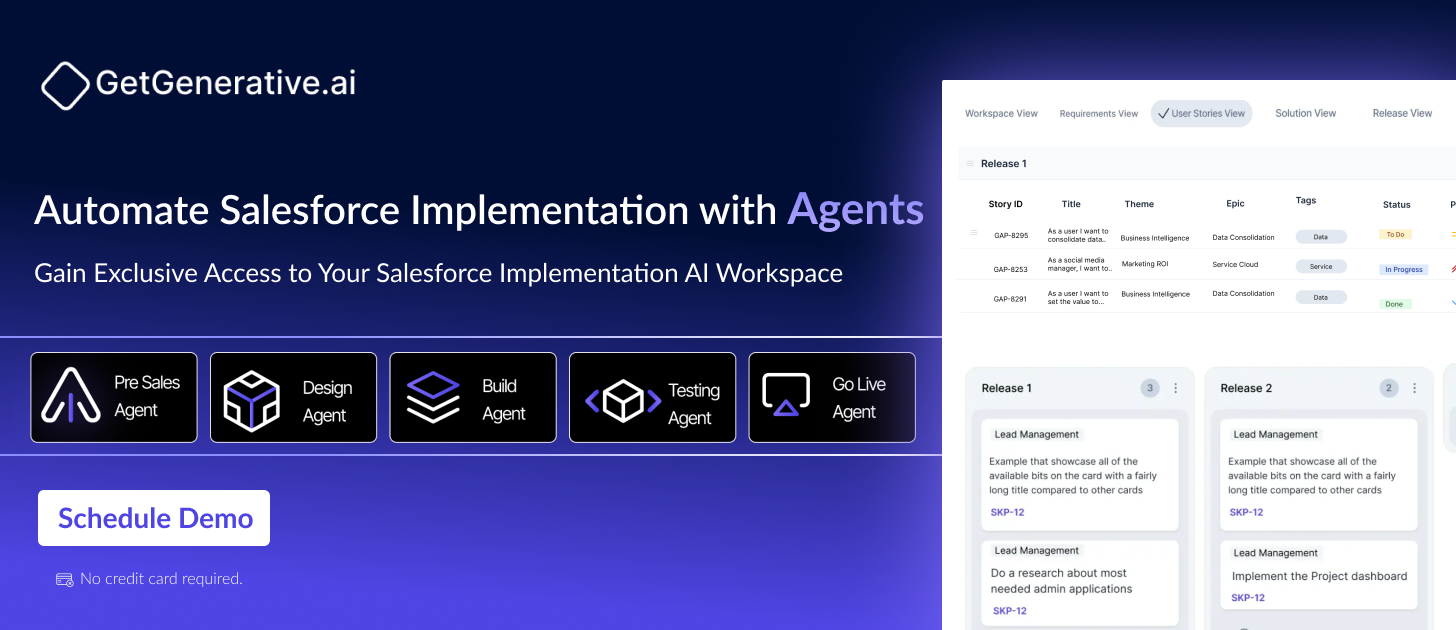What are Different Types of AI Agents?
According to a recent report, the AI agents market is projected to grow from $5.1 billion in 2024 to $47.1 billion by 2030, reflecting a compound annual growth rate of 44.8%.
AI agents are revolutionizing industries by automating processes, making intelligent decisions, and enhancing operational efficiency. From simple automated tasks to complex decision-making systems, AI agents offer diverse capabilities that cater to a wide range of needs. But what exactly are AI agents, and why are they becoming indispensable in modern technology?
Let’s explore the types of AI agents, their unique functionalities, and how they shape our digital world.
What are AI Agents?
An AI agent is a software entity that operates autonomously, perceiving its environment through sensors, making decisions through reasoning, and acting upon its surroundings to achieve predefined goals. This autonomy sets AI agents apart from traditional software, allowing them to operate independently without constant human intervention.
Core components include perception (gathering and interpreting data), reasoning (analyzing information to make decisions), and action (executing decisions to affect the environment).
Also Read – AI Consultant Career Path 2025: The Ultimate Guide to High-Paying Roles
Types of AI Agents: An Overview
AI agents are classified according to their complexity and operational capabilities. Key categories encompass Simple Reflex Agents, Model-Based Reflex Agents, Goal-Oriented Agents, Utility-Driven Agents, Adaptive Learning Agents, Hierarchical Agents, and Multi-Agent Systems (MAS). Each category offers unique attributes and serves distinct roles across diverse industries.
Source: CBInsights
Simple Reflex Agents
Simple reflex agents operate based on immediate perceptions, following predefined condition-action rules without memory or learning capabilities. They respond to specific inputs with corresponding actions, making them suitable for straightforward tasks.
These agents consist of sensors that gather environmental data, condition-action rules that dictate responses, and actuators that execute actions. For example, industrial safety sensors that shut down machinery upon detecting an obstruction or automated sprinklers that activate when smoke is detected are simple reflex agents in action.
While their simplicity ensures quick and efficient responses, their lack of memory and adaptability limits their application in complex, dynamic environments.
Model-Based Reflex Agents
Model-based reflex agents enhance basic reflex agents by maintaining an internal model of the environment. This internal state helps them infer unobservable aspects and make informed decisions.
Key components include a state tracker that monitors the environment, a world model that understands environmental dynamics, and a reasoning component that determines actions. Smart home security systems that distinguish between routine activities and potential threats exemplify model-based agents.
Although more adaptable and versatile than simple reflex agents, their complexity and resource requirements can be challenging, especially in highly dynamic settings.
Goal-Based Agents
Goal-based agents focus on achieving specific objectives by evaluating future outcomes of their actions. Unlike reflex agents, they plan and select actions that bring them closer to their goals.
These agents utilize a goal state defining their objectives, a planning mechanism to devise action sequences, and an evaluation system to assess progress. Autonomous vehicles navigating through traffic or personal assistant apps managing schedules are examples of goal-based agents.
Their strategic approach and adaptability make them suitable for complex tasks, but they require significant computational power and precise goal definitions, which can be resource-intensive.
“Innovation cannot exist without safety.”
- Stuart Russell, Professor of Computer Science at UC Berkeley
Utility-Based Agents
Utility-based agents prioritize actions that maximize overall utility, balancing multiple objectives and making optimal decisions based on a utility function that assigns numerical values to outcomes.
Components include a utility function that quantifies desirability, state evaluation methods, and decision mechanisms. Recommendation systems on platforms like Netflix and algorithmic trading in finance leverage utility-based agents for personalized suggestions and optimized trading decisions.
While they excel in optimizing outcomes and handling trade-offs, the complexity of utility calculations and resource demands pose significant challenges, especially in large-scale applications.
Learning Agents
Learning agents are dynamic AI systems that improve their performance over time by learning from their environment and past experiences. Unlike static agents, they adapt their strategies and decisions through continuous interaction and feedback.
The architecture of learning agents includes a learning element that updates knowledge, a critic that evaluates actions, a performance element that selects actions, and a problem generator that explores new possibilities. AI in gaming, such as DeepMind’s AlphaGo, and personalized healthcare systems that refine treatment plans based on patient data are prime examples.
Their adaptability and autonomy make them powerful tools, but they require extensive data and computational resources. Overfitting and bias are also potential risks, demanding careful design and continuous monitoring.
Hierarchical Agents
Hierarchical agents are structured in layers, with higher-level agents overseeing lower-level ones. This tiered system allows complex tasks to be broken down into manageable subtasks, each handled by specialized agents.
Key components include task decomposition for breaking down objectives, a command hierarchy for control flow, and coordination mechanisms for ensuring cohesive operation. Manufacturing control systems and building automation, where different agents manage heating, lighting, and security, illustrate the utility of hierarchical agents.
While they enhance efficiency and scalability, managing inter-agent coordination and resource allocation can be challenging, particularly in large-scale applications.
“We’re about to empower people more than ever before.”
- Sam Altman, CEO of OpenAI
Multi-Agent Systems (MAS)
Multi-agent systems consist of multiple autonomous agents working together, either cooperatively or competitively, within a shared environment. Each agent operates independently but communicates and collaborates to achieve individual or collective goals.
MAS includes cooperative systems where agents share resources, competitive systems where agents compete for dominance, and mixed systems that combine both. Warehouse management with multiple robots and autonomous drone swarms for agricultural monitoring are common MAS applications.
Despite their advantages in coordination, scalability, and robustness, MAS face challenges in resource management, conflict resolution, and maintaining system efficiency as the number of agents increases.
Also Read – Top Agentic Frameworks Powering Generative AI in 2025
Comparing AI Agents
| AI Agent Type | Complexity | Decision-Making | Adaptability | Applications |
| Simple Reflex Agents | Low | Condition-action rules | Low | Safety sensors, auto-responders |
| Model-Based Agents | Medium | Internal state-based | Medium | Smart security, network monitoring |
| Goal-Based Agents | High | Goal-driven planning | High | Autonomous vehicles, task management |
| Utility-Based Agents | High | Utility function optimization | High | Recommendations, financial trading |
| Learning Agents | Very High | Experience-based learning | Very High | Gaming AI, personalized healthcare |
| Hierarchical Agents | High | Layered control | Medium to High | Manufacturing, building automation |
| Multi-Agent Systems | Very High | Collaborative and competitive | Very High | Warehouse robots, drone swarms |
Conclusion
AI agents are not just futuristic concepts; they are present-day tools reshaping industries with their intelligent capabilities. From simple reflex responses to complex multi-agent collaborations, these digital entities are pushing the boundaries of automation and intelligence. As technology evolves, the role of AI agents will only expand, making them essential for businesses aiming to stay ahead in the digital race.
Ready to transform your Salesforce implementation with cutting-edge AI?
GetGenerative.ai offers AI-powered Workspace + Agents to seamlessly manage your entire Salesforce implementation lifecycle—from Pre-Sales to Go-Live. Boost efficiency, enhance accuracy, and streamline every stage of your project with AI.
FAQs
1. What are AI agents used for?
AI agents are used for automating tasks, enhancing decision-making, managing large-scale operations, and providing personalized user experiences in industries like finance, healthcare, manufacturing, and customer service.
2. How do AI agents differ from traditional software?
Unlike traditional software that follows static instructions, AI agents operate autonomously, learning and adapting from their environment to make intelligent decisions.
3. Which type of AI agent is best for real-time decision-making?
Utility-based agents are best suited for real-time decision-making as they continuously evaluate and optimize actions based on a utility function.
4. Can AI agents operate without human intervention?
Yes, many AI agents operate autonomously, making decisions and executing tasks without human intervention, though initial programming and occasional monitoring are required.
5. What is the most complex type of AI agent?
Learning agents and Multi-Agent Systems are among the most complex, as they involve continuous learning, adaptation, and collaboration among multiple agents.




